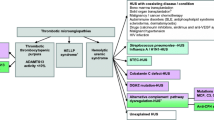Abstract
A 36-year-old man underwent matched unrelated donor bone marrow transplantation for chronic myeloid leukaemia. He developed severe hepatic veno-occlusive disease as an early post-transplant complication. Tissue plasminogen activator was initially felt to be contraindicated since the patient had concomitant pericarditis. Defibrotide was therefore commenced as treatment for veno-occlusive disease. The pericarditis improved but the veno-occlusive disease continued to worsen (peak bilirubin 353 μmol/I). Tissue plasminogen activator followed by a heparin infusion was therefore administered. However, he proceeded to develop haemorrhagic cardiac tamponade that required drainage. Thrombolysis was therefore discontinued and treatment with defibrotide resumed after an interval of 48 h. The veno-occlusive disease gradually resolved and defibrotide was discontinued once the bilirubin had plateaued. He was discharged home on day +52 post-transplant.
Similar content being viewed by others
References
Bearman SI. The syndrome of hepatic veno-occlusive disease after marrow transplantation.Blood 1995;85: 3005–3020.
Lee JHet al. Relevance of proteins C and S, antithrombin III, von Willebrand factor, and factor VIII for the development of hepatic veno-occlusive disease in patients undergoing allogeneic bone marrow transplantation: a prospective study.Bone Marrow Transplant 1998;22: 883–888.
Faioni EM, Mannucci PM. Venocclusive disease of the liver after bone marrow transplantation: the role of hemostasis.Leuk Lymphoma 1997;25(3–4): 233–245.
Morris JDet al. Antithrombin-III for the treatment of chemotherapy-induced organ dysfunction following bone marrow transplantation.Bone Marrow Transplant 1997;20: 871–878.
Patton DFet al. Treatment of veno-occlusive disease of the liver with bolus tissue plasminogen activator and continuous infusion antithrombin III concentrate.Bone Marrow Transplant 1996;17: 443–447.
Hagglund Het al. Norethisterone treatment, a major risk-factor for veno-occlusive disease in the liver after allogeneic bone marrow transplantation.Blood 1998;92: 4568–4572.
Attal Met al. Prevention of hepatic veno-occlusive disease after bone marrow transplantation by continuous infusion of low-dose heparin: a prospective, randomized trial.Blood 1992;79: 2834–2840.
Bearman SIet al. A phase I/II study of prostaglandin E1 for the prevention of hepatic venocclusive disease after bone marrow transplantation.Br J Haematol 1993;84: 724–730.
Essell JHet al. Pilot trial of prophylactic ursodiol to decrease the incidence of veno- occlusive disease of the liver in allogeneic bone marrow transplant patients.Bone Marrow Transplant 1992;10: 367–372.
Essell JHet al. Ursodiol prophylaxis against hepatic complications of allogeneic bone marrow transplantation. A randomized, double-blind, placebo-controlled trial.Ann Intern Med 1998;128(12 Pt 1): 971–981.
Gluckman Eet al. Use of prostaglandin E1 for prevention of liver veno-occlusive disease in leukaemic patients treated by allogeneic bone marrow transplantation.Br J Haematol 1990;74: 277–281.
Marsa-Vila Let al. Prophylactic heparin does not prevent liver veno-occlusive disease following autologous bone marrow transplantation.Eur J Haematol 1991;47: 346–354.
Or Ret al. Low molecular weight heparin for the prevention of veno-occlusive disease of the liver in bone marrow transplantation patients.Transplantation 1996;61: 1067–1071.
Rosenthal Jet al. Phase II trial of heparin prophylaxis for veno-occlusive disease of the liver in children undergoing bone marrow transplantation.Bone Marrow Transplant 1996;18: 185–191.
Salat Cet al. Plasminogen activator inhibitor-1 confirms the diagnosis of hepatic veno-occlusive disease in patients with hyperbilirubinemia after bone marrow transplantation.Blood 1997;89: 2184–2188.
Bearman SI, Shuhart MC, Hinds MS, McDonald GB. Recombinant human tissue plasminogen activator for the treatment of established severe venocclusive disease of the liver after bone marrow transplantation.Blood 1992;80: 2458–2462.
Bearman SI, Lee JL, Baron AE, McDonald GB. Treatment of hepatic venocclusive disease with recombinant human tissue plasminogen activator and heparin in 42 marrow transplant patients.Blood 1997;89: 1501–1506.
Richardson PGet al. Treatment of severe veno-occlusive disease with defibrotide: compassionate use results in response without significant toxicity in a high-risk population.Blood 1998;92: 737–744.
Author information
Authors and Affiliations
Corresponding author
Rights and permissions
About this article
Cite this article
Jenner, M., Micallef, I., Rohatiner, A. et al. Successful therapy of transplant-associated veno-occlusive disease with a combination of tissue plasminogen activator and defibrotide. Med Oncol 17, 333–336 (2000). https://doi.org/10.1007/BF02782200
Received:
Accepted:
Published:
Issue Date:
DOI: https://doi.org/10.1007/BF02782200




